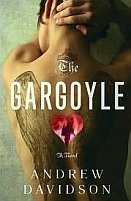|
|
BOOK
ILLUMINATIONS
From Merrimon Book Reviews
HOME
ROMANCE
FICTION SUSPENSE & THRILLERS
MYSTERY
AUTHORS REVIEWER
PROFILES
|
The Gargoyle
 by Andrew Davidson
by Andrew Davidson

Dark, mystical tale of medieval and modern
redemptive love
The initial
pages of Andrew Davidson's THE
GARGOYLE shock with
gut-wrenching meticulous and grotesque images of burns and burn
medicine. The reader recoils from such an image of horror, even in its
scientific presentation, as one might looking at the physical image of
the burned narrator. As a drug addict and porn actor, the darker side
of society and humanity, the temptation is to put away the book in a
safe corner and avert the eyes. When Marianne Engel enters, the reader
is as unsure of her as the narrator and the doctors. Is she crazy and,
if so, how? As she begins to tell her stories, the reader is drawn into
another world far removed from modern times, a world that understands
love and life with a medieval and spiritual vision. Marianne's quest to
suffer and become close to Christ places her right in tune with the
Medieval mystics. Not at all in tune with the modern reality, her
stories get at a different kind of truth, one that is literary and
spiritual --- just what the narrator needs. Indeed, to readers familiar
with the Medieval world, her stories take the reader to mystical
heights that move the heart as Dante's INFERNO becomes internalized
within the narrator's struggles. Although today's standards would view
her ideas as a psychological disorder, this Medieval world view and the
love between them reaches the narrator in ways modern medicine cannot.
The power of the story as story and the redemptive power of her love
gives the narrator a different means with which to view his own story.
As the reader enters into the imaginative space of THE GARGOYLE, the
reader him/herself experiences a similar suspension of modern
sensibilities and an opening into a different kind of reality. Andrew
Davidson's inspired descriptions of the narrator's body and Marianne's
sculptures converge. Through his narrative, the reader turns from
revulsion at the narrator's body to the heart within.
As the novel
progresses, Marianne races against time to bring the
hearts of her gargoyle sculptures to life as the narrator comes face to
face with his addiction to the morphine given to him during his burn
recovery. The tone of the novel and their life becomes more frantic as
modern life crashes in on their world. As Marianne turns her attention
to her sculptures, the reader catches a glimpse of artistic madness.
After reaching such mystical off-the-scale heights in the earlier parts
of the novel, the ending, while very good in and of itself, feels like
a slight let down or slightly expected compared to the unusual, truly
stunning aspects of the rest of the novel. Also, women readers and
feminists might feel a tiny bit of disappointment in the ending which
in its closure turns a novel of poetic beauty towards both the narrator
and Marianne's story into a story that feels more traditionally and
slightly more exclusively the hero's journey. For most of the novel,
his stunning portrait of Marianne reaches such an exquisite level of
detail, unlike some Medieval texts' depiction of women, that this
reader expected something a bit more unusual. That being said, the
ending is still very good, but just not quite at the level of the rest
of the novel.
Andrew
Davidson's THE GARGOYLE is an
absolute must read for any
medieval junkie. The author's sense of the medieval literature and
Christianity makes this medievalist feel right at home. The unusual
modern setting and characters bring a freshness to a classic vision,
renewing medieval sensibilities with an eclectic powerful vision of
literature internalized in his heart and externalized in his body. Like
Dante's Beatrice, Marianne brings the reader to a space of redemptive
love but THE GARGOYLE is also
more than just a slavish modernization of
Dante's literary and spiritual vision. Andrew Davidson intertwines
several strands of medieval literary and Christian mysticism in an
unconventional manner. Although the beginning was excruciatingly
painful in terms of the detail, and the narrator's past makes him a
reject from polite circles of society, these details are exactly the
darkness from which the level of redemption becomes so moving. If you
are looking for a light easy read, this is not the book for you. If you
have a deep love and knowledge of the medieval literature and Christian
mysticism, and also enjoy the dark and the eclectic in your modern
reads, Andrew Davidson's THE GARGOYLE
is stunning, a book to reread and
cherish.
Publisher:
Doubleday
(August 2008)
Reviewed by Merrimon,
Merrimon Book Reviews
Review Courtesy of Amazon Vine

|
|
|